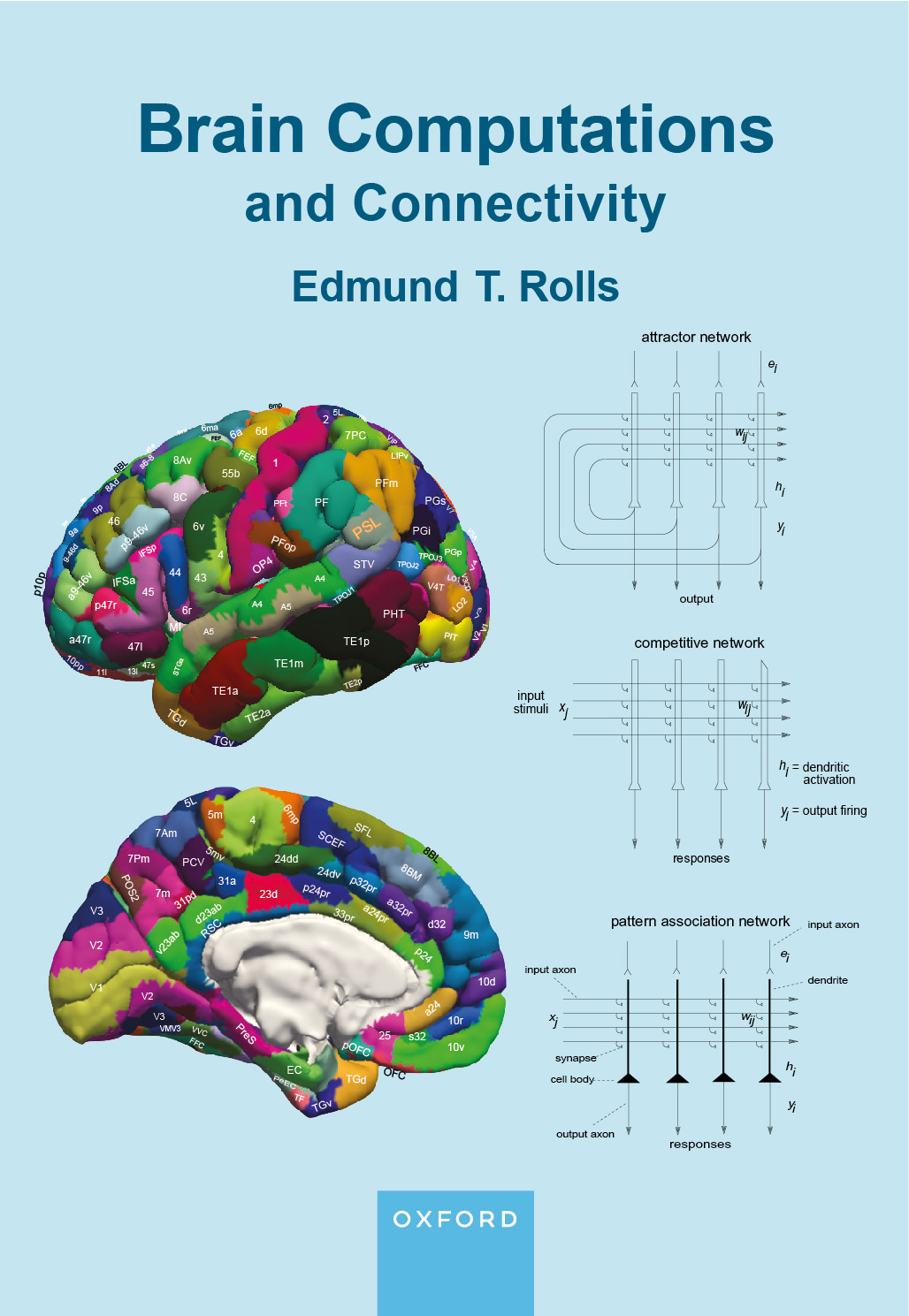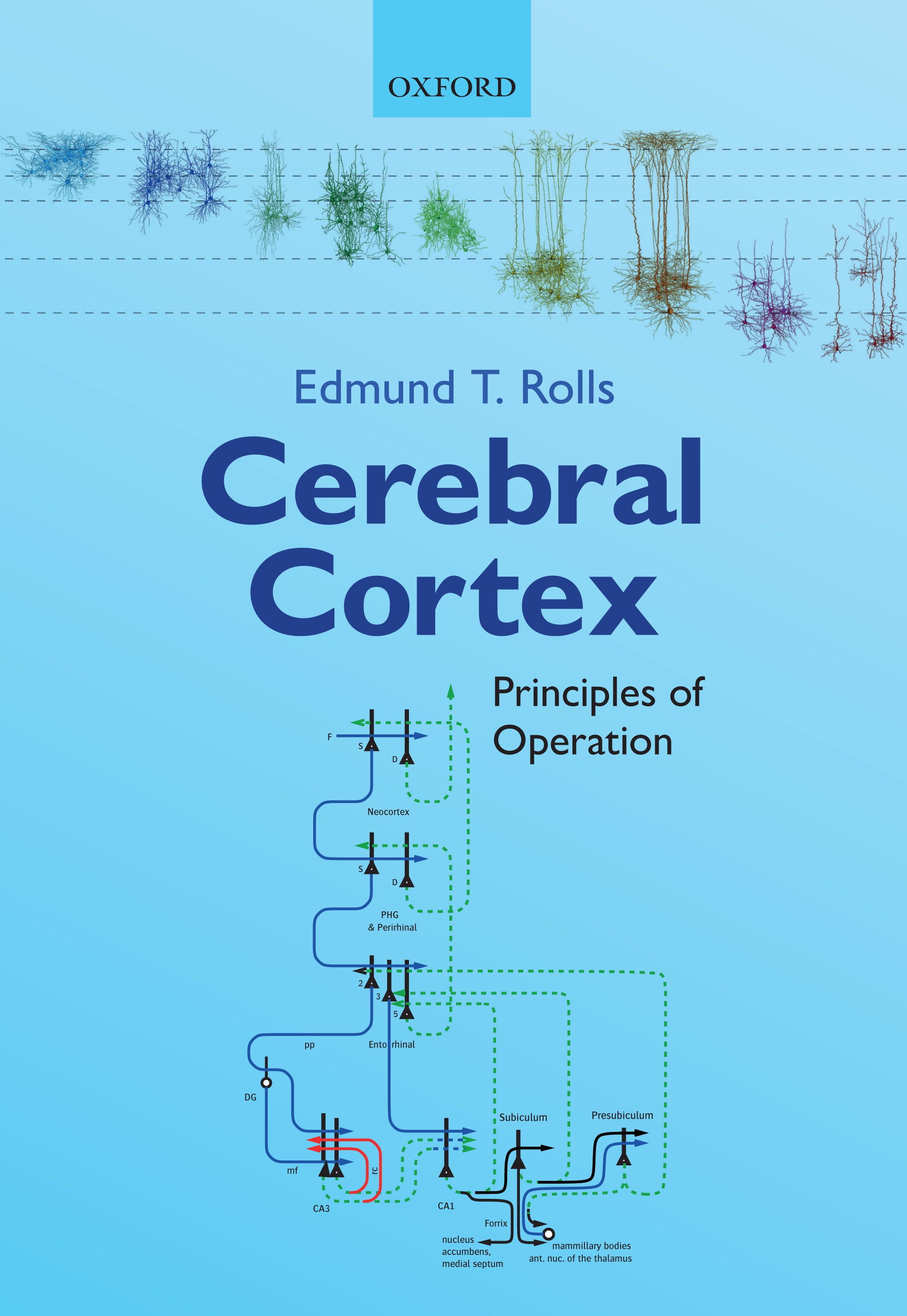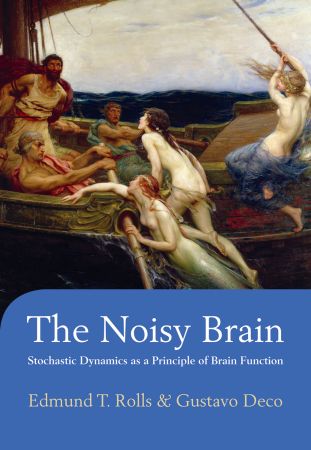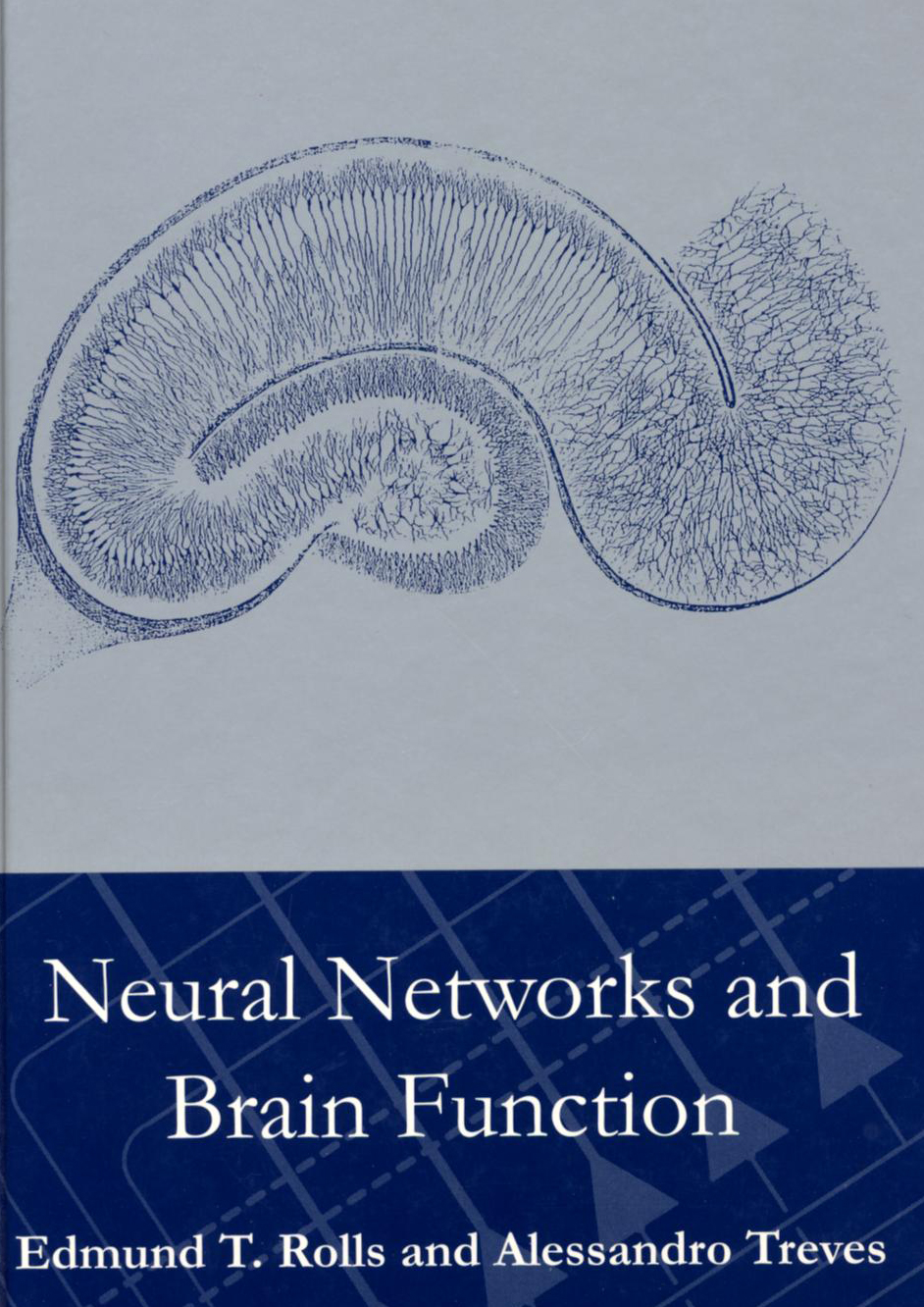




|
Overview:
Rolls and
colleagues discovered spatial view neurons, object-and-spatial view
neurons, reward-and-spatial view neurons, and whole body motion neurons
(termed 'speed cells' in rodents) in the hippocampus, and head
direction cells in the presubiculum, of primates. These neurons provide
a foundation for understanding how the primate including human
hippocampal system operates in episodic memory, and navigation using
landmarks (662, 692, 702). The neurophysiological
discoveries are complemented by a theory of how neuronal networks in
the hippocampal system operate using pattern separation and pattern
completion, and what remains the only quantitative theory of how
information is recalled from the hippocampus to the neocortex (686, 689).
Developments in understanding the effective connectivity of the
hippocampal system in humans lead to a new approach to episodic memory
in which a key component of episodic memory is reward / emotional value
from the orbitofrontal cortex (657, 649, 647) which is combined in the hippocampus with 'what' information about objects and faces from the inferior temporal cortex (656) and 'where' information about scenes via the ventromedial cortical visual stream to the parahippocampal scene area (656, 662, 682, 686, 688).
This in turn leads to a new approach to memory consolidation in which
the reward component of episodic memory influences memory consolidation
in the neocortex, acting in part by the orbitofrontal cortex input to
the basal forebrain cholinergic neurons (657, 665). Key
summary descriptions are in 702, 692, 686, 657, 665, 633, B16, 584, 594, 539, 550 and 186.
The discovery of hippocampal
and parahippocampal spatial view neurons that provide an allocentric representation of
spatial
locations being viewed, and that are updated by self-motion (129, 152, 202, 237, 244,
247, 256,
267, 594, B16, 633, 662, 672, 702).
The discovery of hippocampal
spatial view neurons that combine information about spatial view and
the
objects (130, 131, 380)
or rewards (387), and are
involved in recall (399), providing
a basis for implementing episodic memory (657, 662, 539,
B12, 594, 662, 672, B16, 686, 690, 692, 702).
A theory for how hippocampal spatial view cells are involved in memory and navigation (584, 594, 539,
B12, B16, 633, 662, 672, 686), and the pathways involved in humans (682, 686, 688, 695, 702).
These discoveries of the importance of spatial view representations in
the primate and human hippocampus, and the pathways involved, are
revolutionizing (702) our understanding of the functions of the medial
parahippocampal cortex and hippocampus in primates and humans for
memory and navigation in which viewed locations and landmarks in scenes are important (662, 682, 633, 672, 594, 539, 685, 686, 692).
In contrast, given the representations of the place where
the individual is located that are found in the rodent hippocampal and
medial entorhinal cortex system, navigation in rodents is considered to
involve blind path integration from place to place using head
direction, the speed of travel, and the time (662, 682, 672, 686, 692, B16, 702).
These revolutions (702) in
our understanding of the operation of the primate including human
hippocampus is founded on the following multidisciplinary,
complementary, and coherent set of discoveries in neuroscience (692): on the
discovery of spatial view cells and their properties (702, 662, 672, 256, 247, 244, 237, 399, 387, 380, 202, 152, 129, 130); on the pathways to the human hippocampus for spatial scenes (702, 682, 688, 695, 685, 662, 656), for objects and faces (676, 685, 695), and for reward value and emotion (649);
on the activations and connectivity of the human hippocampus during
object-location, reward-location, and word-pair episodic memory (690);
on a computational theory of the storage and recall of memory in the
hippocampus-neocortical system (686, 689, 186, 125);
on a theory of how scene representations are built using spatial view
cells in the ventromedial cortical visual pathway (696, 692); on how
orbitofrontal cortex to cholinergic neuron connectivity may be
important in memory consolidation in the hippocampus and neocortex (657, 649); and on developments in understanding navigation in primates including humans using visual inputs (633) and the coordinate transforms required (612), in contrast to the blind place to place path integration of rodents (702).
Hippocampal neurons in primates that respond
to a combination of spatial view and place, or to place (202).
The discovery of whole-body
motion neurons in the hippocampus (184), more recently termed 'speed
cells' (701). These are relevant to hippocampal
spatial representation update by self-motion, i.e. idiothetic update (633, 686).
Hippocampal
neurons that respond to a combination of spatial view and whole body
motion (184, 202).
Head
direction cells in the primate presubiculum (271).
The discovery of a
representation of long-term familiarity memory in the perirhinal cortex, which may contribute to ownership
(343, 388).
A
theory and model of hippocampal operation and episodic memory,
including pattern separation and pattern completion (111, 125,
136, 163,
186, 200,
205,
258, 266,
268, 300,
306, 307,
309, 345,
370, 403,
411, 415,
433,
453, 479, 504, 507, 521, 527,
529,
531,
539,
545,
550, 571, 584, 643, 672,
B12, B16, 686).
A dynamical systems
approach using integrate-and-fire neurons to
neocortical-hippocampal-neocortical function that shows that memory
recall to the neocortex takes in the order of 100 ms, which is
sufficiently rapid for the backprojections to be modified using storage
in order to implement later recall to the neocortex (689). The
operation of the whole network has implications for how the hippocampus
is involved in the formation of new neocortical semantic memories (689).
Extensive cortical connectivity of the human hippocampal memory system shown by diffusion tractography (635), functional connectivity (644), and effective connectivity (647, B16, 662, 661, 682, 686, 688, 694, 695).
One discovery is of the effective connectivity
of the human orbitofrontal cortex, vmPFC and anterior cingulate
cortex, which shows how reward value and emotion can reach the
hippocampal memory system to become incorporated in episodic memory
(649, 657, B16). This also shows how these cortical regions have connectivity
with the septum and basal forebrain cholinergic systems, providing a
mechanism that may contribute to the memory impairments produced by
vmPFC damage in humans (649, 657).
Another discovery is the identification
in humans using effective connectivity of a ventromedial cortical visual stream
via the ventromedial visual cortical areas to the parahippocampal scene (or
place) area and thereby provides a 'where' input to the hippocampus (656, 662, B16, 682, 676, 686,
688, 695). To complement the empirical discoveries, I have developed a computational theory and model of how visual
feature combination neurons produce spatial view cells along the
ventromedial scene pathway that are linked together in a continuous
attractor network in the medial parahippocampal cortex and hippocampus
to form allocentric scene representations (696). Function has been added to the connectivity of this ventromedial
visual cortical stream by showing with 956 participants that the
cortical regions in this stream in the Human Connectome Project
Multimodal Parcellation atlas are selectively activated by scenes (685)
especially in the right hemisphere () in males (), and that these
regions are activated during object-location and reward-location
episodic memory (690).
In addition, I have shown how the hippocampal
episodic memory system has connectivity to anterior temporal lobe semantic
multimodal including visual regions, and to semantic inferior parietal visual
cortical regions, and have produced a theory and model of how the
hippocampal episodic memory inputs inputs could help to form
semantic memories (694).
The identification
in humans of a pathway from inferior parietal PGp to the
hippocampus which is implicated in the self-motion (idiothetic) update
of parahippocampal and hippocampal spatial view cells using eye
position and head direction information (656, 655, 612, 662, B16, 682).
A theory and model
of the generation of time in the hippocampal memory system which can provide a 'when' component of episodic memory. Entorhinal
cortex time ramping cells produce through a competitive network
hippocampal time cells, providing neuronal mechanisms to encode the
order of events (605). The theory shows how cells could be generated that show 'replay' and 'reverse replay' (605, B16).
A theory and model
of coordinate transforms in the dorsal visual system using a
combination of gain modulation and slow or trace rule competitive
learning. The theory starts with retinal position inputs gain modulated
by eye position to produce a head centred representation, followed by
gain modulation by head direction, followed by gain modulation by
place, to produce an allocentric representation in spatial view
coordinates useful for the idiothetic update of hippocampal spatial
view cells (612). This is important in the theory of navigation using spatial view cells when the view details are obscured (633, 662, B16).
A theory of navigation in
humans and other primates that utilizes hippocampal spatial view cells
to navigate from landmark to landmark (633, 662, B16, 686).
This is an alternative to navigation involving place cells, and does not require a spatial cognitive Euclidean map. Idiothetic
update by head direction and whole body motion ('speed' 701) cells is part of the
theory (633). Allocentric bearing to a landmark cells may also be involved in a related type of navigation (633).
A theory of how spatial view cells and hippocampal attractor networks are involved in the art of memory (the method of loci) (571, 595).
Hypertension and impaired memory: even moderate hypertension is associated with reduced hippocampal functional connectivity and impaired memory (625).
The
storage capacity of autoassociation and pattern association networks
with
sparse representations and diluted connectivity (150,
154, 222,
228, 515, 545, 672,
B12, B16, 686, 689).
The
discovery that basal
forebrain, probably cholinergic neurons, that project to the cortex,
have responses to forebrain-decoded reward, aversive, and novel stimuli
(144, 145,
146, 177, B7, B11).
These are thought to play a role in
keeping the cerebral cortex alert to
potentially important stimuli, and reducing the adaptation of cortical
neurons, and in facilitating memory consolidation (657, B12, B16).
In humans the basal forebrain and septal regions receive inputs
from the medial orbitofrontal and anterior cingulate cortex (649, 657).
Reduction in the performance of this system may contribute to some of
the
cognitive changes during aging (B8, B9,
B12,
540).
Mechanisms
involving synaptic facilitation that enable several items to be held
simultaneously in short-term memory (523)
and that may be useful in the syntax for language (537).
Information
can be retrieved from biologically plausible attractor neuronal
networks very
rapidly (in approximately 2.5 time constants of the synapses) (with A.Treves
and colleagues)
(222,
235, 294, 689).
This
makes cortical computation with attractor networks
possible (B8,
B12, B16).
The effective
connectivity of the human prefrontal cortex using the HCP-MMP human
brain atlas has identified different systems involved in working memory
(660). Inferior prefrontal regions have connectivity with the inferior
temporal visual cortex and orbitofrontal cortex, are implicated in
working memory for ‘what’ processing streams, and provide connectivity
to language systems including 44, 45, 47l, TPOJ1 and STV. The
dorsolateral prefrontal cortex regions that include area 46 have
connectivity with parietal area 7 and somatosensory inferior parietal
regions and are implicated in working memory for actions and planning.
The dorsal prefrontal regions including 8Ad and 8Av have connectivity
with visual regions of the inferior parietal cortex including PGs and
PGi, and are implicated in visual and auditory top-down attention
(660). The
underlying computational mechanisms have been described (B16).
|